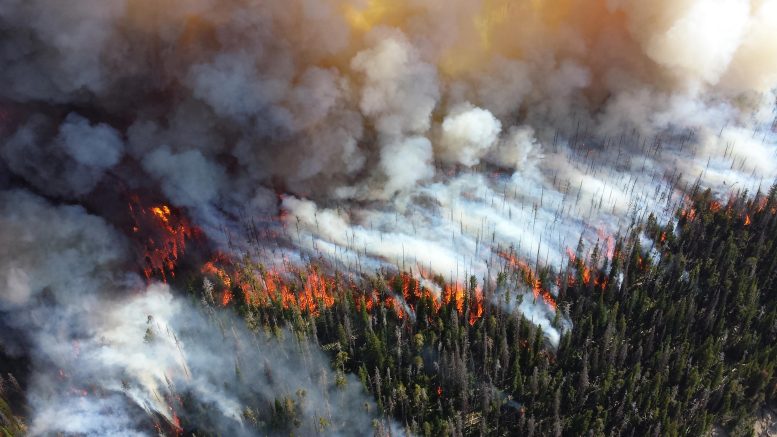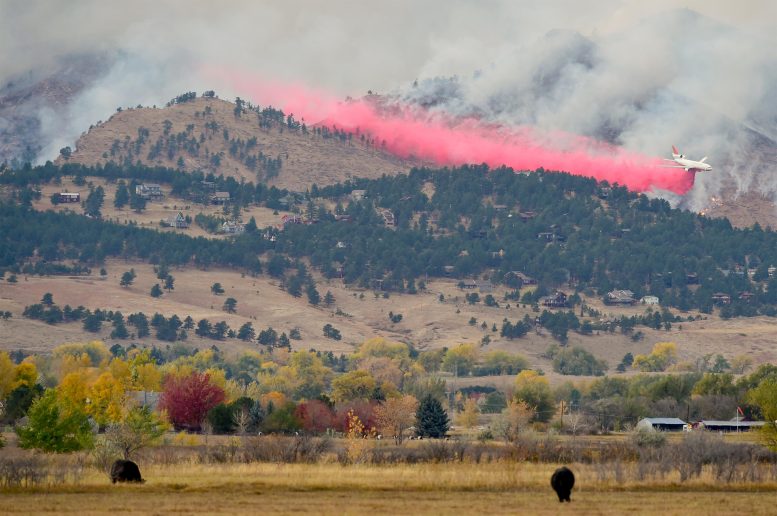Palpable Change in Fire Dynamics Confirmed: U.S. Wildfires 4x Larger, 3x More Frequent Since 2000

This is a 2013 photo of the Alder Fire in Yellowstone National Park. Credit: Mike Lewelling, National Park Service
New analysis confirms a palpable change in fire dynamics already suspected by many.
Fires have gotten larger, more frequent, and more widespread across the United States since 2000, according to a new CIRES Earth Lab-led paper. Recent wildfires have stoked concern that climate change is causing more extreme events, and the work published recently in Science Advances shows that large fires have not only become more common, they are also spreading into new areas, impacting land that previously did not burn.
“Projected changes in climate, fuel, and ignitions suggest that we’ll see more and larger fires in the future. Our analyses show that those changes are already happening,” said Virginia Iglesias, a research scientist with CIRES’ Earth Lab and lead author of the paper.
To evaluate how the size, frequency, and extent of fires have changed in the United States, Iglesias and her colleagues analyzed data from over 28,000 fires that occurred between 1984 and 2018 from the Monitoring Trends in Burn Severity (MTBS) dataset, which combines satellite imagery with the best available state and federal fire history records.

A DC-10 drops fire retardant on the edge of the 2020 Calwood Fire in Colorado. Credit: William Travis, University of Colorado
The team found that there were more fires across all regions in the contiguous United States from 2005 to 2018 compared to the previous two decades. In the West and East, fire frequency doubled, and in the Great Plains, fire frequency quadrupled. As a result, the amount of land burned each year increased from a median of 1,552 to 5,502 square miles (4,019 to 14,249 km2) in the West and from 465 to 1,295 square miles (1,204 to 3,354 km2) in the Great Plains.
The researchers also took a closer look at the most extreme fire events in each region. They found that in the West and Great Plains, the largest wildfires grew bigger and ignited more often in the 2000s. Throughout the record, large fires were more likely to occur around the same time as other large fires.
“More and larger co-occurring fires are already altering vegetation composition and structure, snowpack and water supply to our communities,” Iglesias explained. “This trend is challenging fire-suppression efforts and threatening the lives, health, and homes of millions of Americans.”
Finally, the team discovered that the size of fire-prone areas increased in all regions of the contiguous United States in the 2000s, meaning that not only is the distance between individual fires getting smaller than it was in the previous decades, but also that fires are spreading into areas that did not burn in the past.
These results confirm a palpable change in fire dynamics that has been suspected by the media, public, and fire-fighting officials. Unfortunately, the results also align with other troubling risk trends, such as the fact that development of natural hazard zones is also increasing wildfire risk. “These convergent trends, more large fires plus intensifying development, mean that the worst fire disasters are still to come,” said co-author and Earth Lab deputy director, William Travis.
The study authors suggest that to adapt and build resilience to wildfire impacts, planners and stakeholders must account for how fire is changing and how it is impacting vulnerable ecosystems and communities.
Reference: “U.S. fires became larger, more frequent, and more widespread in the 2000s” by Virginia Iglesias, Jennifer K. Balch and William R. Travis, 16 March 2022, Science Advances.
DOI: 10.1126/sciadv.abc0020
No comments:
Post a Comment